![]()
![]()
![]()
Use LEFT and RIGHT arrow keys to navigate between flashcards;
Use UP and DOWN arrow keys to flip the card;
H to show hint;
A reads text to speech;
30 Cards in this Set
- Front
- Back
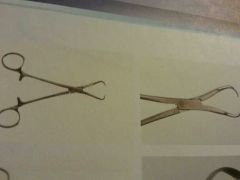
|
Name: backhaus towel clamp/perforating towel clamp Use: grasping tissue that will be removed; securing towels or drapes; holding or reducing small bone fractures Info: perforating tips
|
|
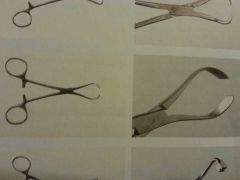
|
Name: edna towel clamp/lorna Use: securing drapes; securing suction, ESU, or camera cords to the drape Info: nonperforating jaws |
|

|
Name: peers towel clamp Use: securing drapes; securing suction, ESU, camera cords to the drape Info: nonperforating jaws |
|

|
Name: roeder towel clamp Use: grasping tissue that will be removed; securing towels or drapes; holding or reducing small bone fractures Info: perforating tips; ball stops on tips |
|

|
Name: foerster sponge foreceps/sponge stick/sponge-holding foreceps Use: grasping tissue; holding raytec sponges Info: smooth or serrated jaws; straight or curved shank |
|
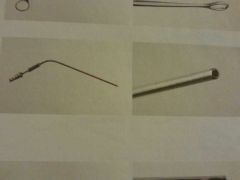
|
Name: frazier suction tip/nasal suction/ENT suction/neurosuction Use: suctioning small quantities of fluid; suctioning in small areas Info: short or long tips; 6 Fr to 16 Fr diameter; metal or disposable; angled; thumb hole controls suction on/off
|
|

|
Name: poole suction/abdominal suction Use: suctioning large quantities of fluid/blood Info: removable sheath allows cannula to suction smaller areas; both pieces must be accounted for in instrument count |
|
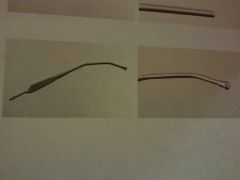
|
Name: yankauer suction/tonsil suction Use: suctioning fluid or blood; may be used to suction smoke Info: most commonly used suction; metal or plastic versions; if using two-piece metal suction with removable tip, both pieces must be accounted for in instrument count |
|
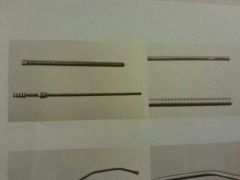
|
Name: poole suction/abdominal suction Use: suctioning large quantities of fluid/blood Info: removable sheath allows cannula to suction small areas; both pieces must be accounted for in instrument count |
|
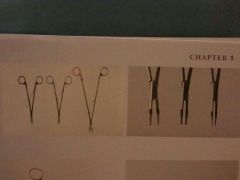
|
Name: clip-applying forceps/hemoclip appliers Use: holding and applying hemoclips Info: small, medium, and large; straight or angled jaws; finger rings may be color coded to match clip cartridges |
|
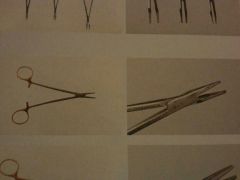
|
Name: crile-wood needle holder/crile-wood needle driver Use: holding small or medium-sized suture needles Info: used in delicate suturing; some brands have tungsten carbide jaw inserts |
|
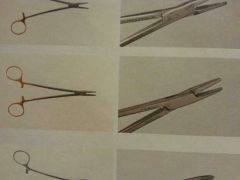
|
Name: mayo-hegar needle holder/needle driver Use: holding heavy suture needles Info: widely used in general surgery; some brands have tungsten carbide jaw inserts; MRI version available |
|
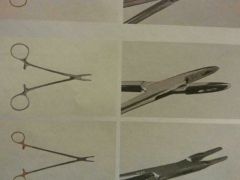
|
Name: baumgartner needle holder Use: holding suture needles Info: jaws shorter than crile-wood or mayo-hegar |
|
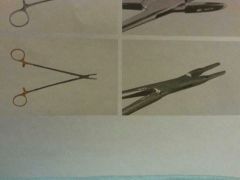
|
Name: ryder needle holder/french eye needle holder/neurosurgical needle holder Use: holding small suture needles; used mostly in vascular, intestinal, plastic, or neurosurgery Info: narrow jaws; smootg or tungsten carbide jaws |
|
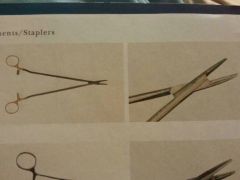
|
Name: debakeu cardiovascular needle holder Use: holding fine suture needles for vascular or cardiac procedures Info: fine, straight jaws |
|
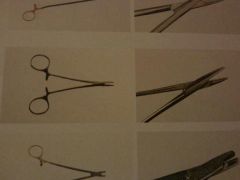
|
Name: webster needle holder Use: holding fine suture needles; used mostly in plastic or ENT surgery Info: smooth or carbide insert jaws |
|
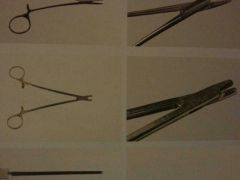
|
Name: sternal wire twister Use: placing retention or wire sutures; twisting wire Info: extra-heavy jaws |
|
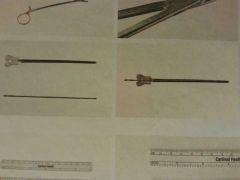
|
Name: probe and grooved director/larry probe and grooved director/fistula probe Use: probing fistulas, ducts, etc. Info: "ear"-shaped end of the director referred to as a tongue tie |
|
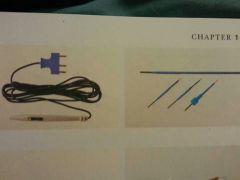
|
Name: electrosurgical pencil/active electrode/bovie pencil Use: cauterizing blood vessels and/or cutting a tissue Info: a variety of tips to use with the pencil; tip types include blades, points, extensions, and balls |
|
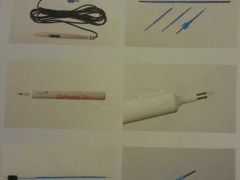
|
Name: handheld cautery Use: cauterizing fine vessels or tissue; evacuating subungual hematoma Info: single-patient use; shelf life approximately 4 years |
|
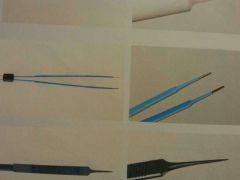
|
Name: gerald bipolar foreceps Use: cauterizing small blood vessels Info: delicate, narrow tips; straight or bayonet-shaped handle |
|

|
Name: malis mirror-finish bipolar cautery foreceps Use: cauterizing small blood vessels or delicate tissue Info: sharp or blunt tips; straight, angled, or looped tips; straight or bayonet-shaped handle; available with special tip for use with irrigating system |
|
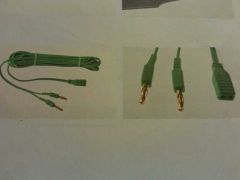
|
Name: bipolar cautery cord Use: attaching bipolar cautery foreceps to electrosurgical power unit Info: use with bipolar cautery foreceps only |
|
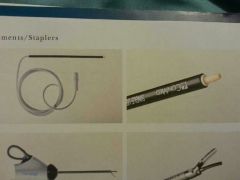
|
Name: argon beam coagulator Use: hemostasis Info: used argon gas and electrocautery to cauterize blood vessels |
|
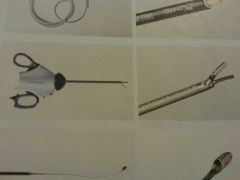
|
Name: harmonic scalpel Use: cutting and cauterizing tissue Info: uses ultrasonic wave technology to cut and cauterize tissue at lower temperatures |
|

|
Name: desjardin gallstone scoop Use: removing gallstones Info: 6mm, 7mm, 8mm, or 9mm |
|
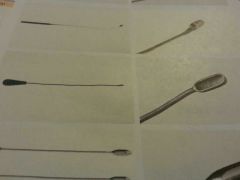
|
Name: mayo common duct scoop Use: removing stones from the common duct Info: small, medium, or large |
|
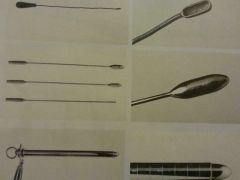
|
Name: bakes commin bile duct dilators Use: dilating the common bile duct Info: 3mm to 11mm tips |
|

|
Name: sigmoidoscope Use: viewing inside of the anal canal and sigmoid colon Info: obturator is placed inside the scope for insertion and then removed |
|
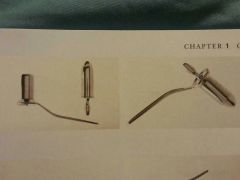
|
Name: anoscope with obturator Use: retracting/viewing anal canal Info: rounded obturator used for insertion and then removed
|

